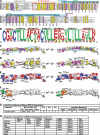Structural and biophysical analysis of BST-2/tetherin ectodomains reveals an evolutionary conserved design to inhibit virus release
- PMID: 21084286
- PMCID: PMC3024793
- DOI: 10.1074/jbc.M110.190538
Structural and biophysical analysis of BST-2/tetherin ectodomains reveals an evolutionary conserved design to inhibit virus release
Abstract
BST-2/tetherin is a host antiviral molecule that functions to potently inhibit the release of enveloped viruses from infected cells. In return, viruses have evolved antagonists to this activity. BST-2 traps budding virions by using two separate membrane-anchoring regions that simultaneously incorporate into the host and viral membranes. Here, we detailed the structural and biophysical properties of the full-length BST-2 ectodomain, which spans the two membrane anchors. The 1.6-Å crystal structure of the complete mouse BST-2 ectodomain reveals an ∼145-Å parallel dimer in an extended α-helix conformation that predominantly forms a coiled coil bridged by three intermolecular disulfides that are required for stability. Sequence analysis in the context of the structure revealed an evolutionarily conserved design that destabilizes the coiled coil, resulting in a labile superstructure, as evidenced by solution x-ray scattering displaying bent conformations spanning 150 and 180 Å for the mouse and human BST-2 ectodomains, respectively. Additionally, crystal packing analysis revealed possible curvature-sensing tetrameric structures that may aid in proper placement of BST-2 during the genesis of viral progeny. Overall, this extended coiled-coil structure with inherent plasticity is undoubtedly necessary to accommodate the dynamics of viral budding while ensuring separation of the anchors.
Figures





Similar articles
-
Structural basis of HIV-1 tethering to membranes by the BST-2/tetherin ectodomain.Cell Host Microbe. 2010 Apr 22;7(4):314-323. doi: 10.1016/j.chom.2010.03.005. Cell Host Microbe. 2010. PMID: 20399176 Free PMC article.
-
The tetherin/BST-2 coiled-coil ectodomain mediates plasma membrane microdomain localization and restriction of particle release.J Virol. 2012 Feb;86(4):2259-72. doi: 10.1128/JVI.05906-11. Epub 2011 Nov 30. J Virol. 2012. PMID: 22130541 Free PMC article.
-
The size and conservation of a coiled-coil structure in the ectodomain of human BST-2/tetherin is dispensable for inhibition of HIV-1 virion release.J Biol Chem. 2012 Dec 28;287(53):44278-88. doi: 10.1074/jbc.M112.418822. Epub 2012 Nov 14. J Biol Chem. 2012. PMID: 23152502 Free PMC article.
-
Antiviral activity of the interferon-induced cellular protein BST-2/tetherin.AIDS Res Hum Retroviruses. 2009 Dec;25(12):1197-210. doi: 10.1089/aid.2009.0253. AIDS Res Hum Retroviruses. 2009. PMID: 19929170 Free PMC article. Review.
-
The great escape: viral strategies to counter BST-2/tetherin.PLoS Pathog. 2010 May 13;6(5):e1000913. doi: 10.1371/journal.ppat.1000913. PLoS Pathog. 2010. PMID: 20485522 Free PMC article. Review.
Cited by
-
Unique Evolution of Antiviral Tetherin in Bats.J Virol. 2022 Oct 26;96(20):e0115222. doi: 10.1128/jvi.01152-22. Epub 2022 Sep 29. J Virol. 2022. PMID: 36173189 Free PMC article.
-
CD317 Activates EGFR by Regulating Its Association with Lipid Rafts.Cancer Res. 2019 May 1;79(9):2220-2231. doi: 10.1158/0008-5472.CAN-18-2603. Epub 2019 Mar 19. Cancer Res. 2019. PMID: 30890618 Free PMC article.
-
Functional antagonism of rhesus macaque and chimpanzee BST-2 by HIV-1 Vpu is mediated by cytoplasmic domain interactions.J Virol. 2013 Dec;87(24):13825-36. doi: 10.1128/JVI.02567-13. Epub 2013 Oct 9. J Virol. 2013. PMID: 24109238 Free PMC article.
-
C-terminal hydrophobic region in human bone marrow stromal cell antigen 2 (BST-2)/tetherin protein functions as second transmembrane motif.J Biol Chem. 2011 Nov 18;286(46):39967-81. doi: 10.1074/jbc.M111.287011. Epub 2011 Sep 21. J Biol Chem. 2011. PMID: 21937450 Free PMC article.
-
Bone marrow stromal cell antigen 2: Tumor biology, signaling pathway and therapeutic targeting (Review).Oncol Rep. 2024 Mar;51(3):45. doi: 10.3892/or.2024.8704. Epub 2024 Jan 19. Oncol Rep. 2024. PMID: 38240088 Free PMC article. Review.
References
-
- Sauter D., Specht A., Kirchhoff F. (2010) Cell 141, 392–398 - PubMed
MeSH terms
Substances
Associated data
- Actions
LinkOut - more resources
Full Text Sources
Molecular Biology Databases

